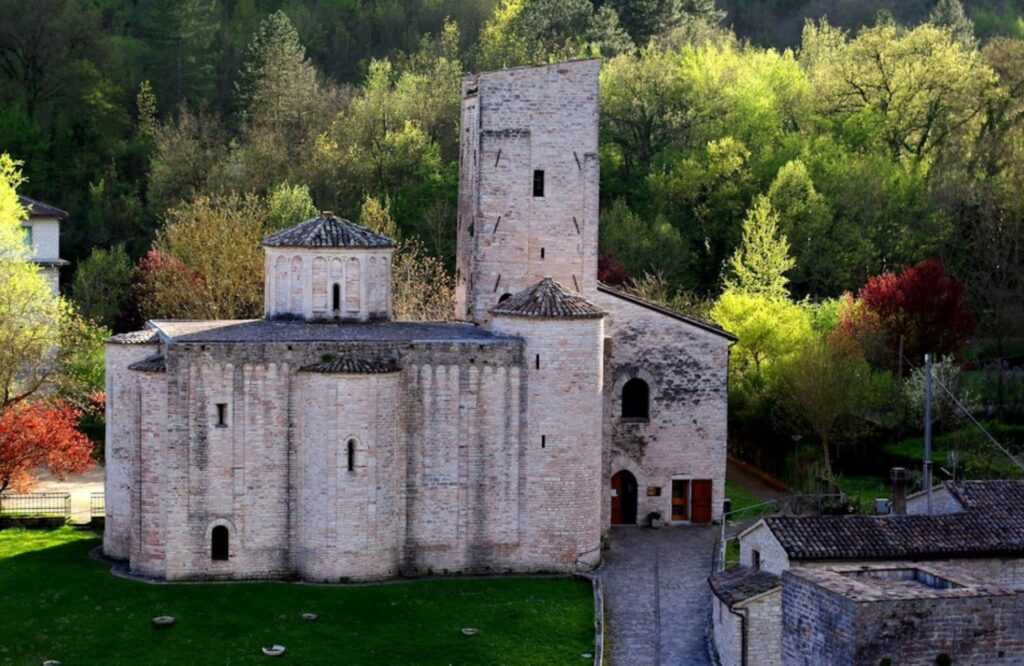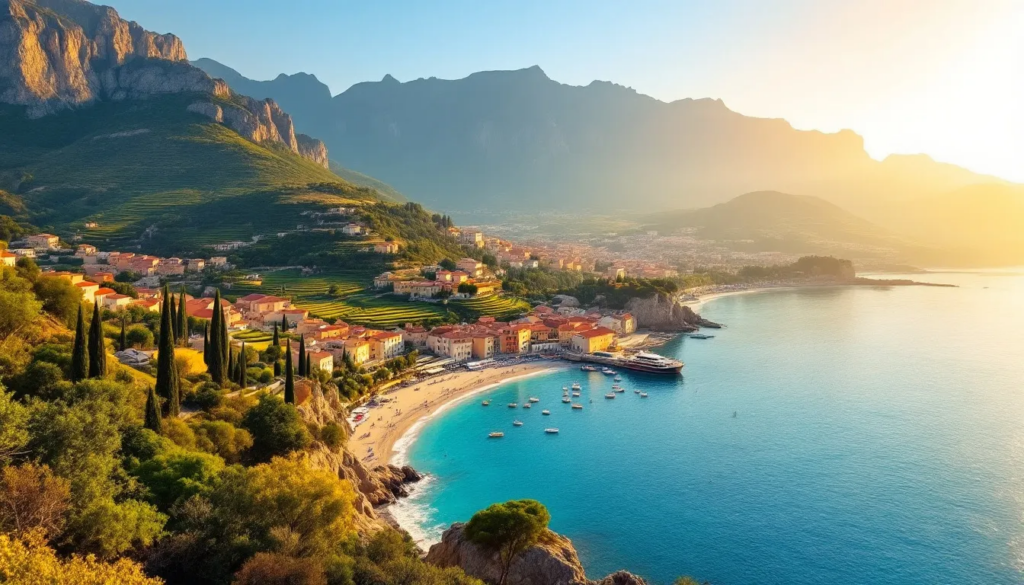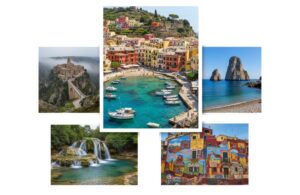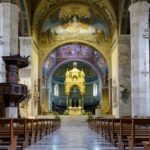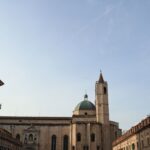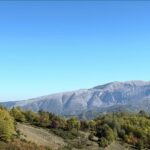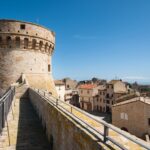San Vittore is more than just a name found on maps of Italy. It represents layers of history, faith, and architecture that continue to shape Italian identity. Across the country, you’ll find several places called San Vittore, each reflecting a unique story tied to Italy’s patron saint, Saint Victor. From the ancient church and basilica in Milan to the medieval abbey located in Le Marche, and even the historic San Vittore Prison, these sites together tell a remarkable narrative of endurance and transformation.
At True Colors of Italy, we design private, small-group excursions that help travelers explore beyond Italy’s famous cities and into the heart of local history. Our tours in the Le Marche region highlight places like San Vittore delle Chiuse, where Romanesque architecture and peaceful countryside coexist. Whether you’re standing before a frescoed chapel, wandering a quiet piazza, or sampling regional food, you’ll see Italy through the eyes of locals who preserve its true colors every day.
The Legacy of Saint Victor
The name San Vittore appears in several regions across Italy, but all trace back to Saint Victor, the patron saint of soldiers and prisoners. Victor was a Roman soldier executed in Milan around 303 AD for refusing to abandon his Christian faith. His legacy led to the construction of churches, chapels, and even the naming of a city quarter in his honor.
San Vittore in Milan
The Basilica di San Vittore al Corpo, located near Piazza San Vittore in Milan, was originally built in the 4th century and later reconstructed during the Renaissance by architect Galeazzo Alessi. The basilica remains one of Milan’s most historically rich religious sites, featuring frescoed ceilings, marble columns, and paintings depicting the life of Saint Victor. Some chapels, completed in the 17th century, contain works by Bernardino Luini, a pupil of Leonardo da Vinci. With its intricate baroque details and serene atmosphere, the church stands as a striking symbol of faith and art in Milan.
San Vittore in Le Marche and Beyond
In the region of Le Marche, the Abbey of San Vittore delle Chiuse tells a different story. Built around the year 1000, this Benedictine abbey reflects Byzantine influences and early medieval craftsmanship. During World War II, it became a refuge for displaced families and Jews fleeing persecution, adding a layer of human resilience to its sacred history. Meanwhile, the San Vittore Prison in Milan, constructed in 1872, represents another side of the name’s legacy. Used by the Nazis to detain partisans and Jewish prisoners during the occupation, it now serves as a correctional facility offering rehabilitation programs. Its chapel, still active today, remains a quiet symbol of redemption and hope, values rooted in Saint Victor’s enduring story. Visit San Vittore delle Chiuse and explore centuries of Italian heritage through a guided tour in the heart of Le Marche.
Top Experiences in San Vittore
Exploring San Vittore reveals a blend of Italy’s spiritual, cultural, and historical heritage. From the hilltop abbeys of Le Marche to the art-filled piazzas of Milan, each site offers travelers a glimpse into centuries of devotion and craftsmanship that continue to shape Italian identity.
Begin your journey at the Abbey of San Vittore delle Chiuse, a 10th-century masterpiece nestled among the green hills of Le Marche. Built from finely carved limestone, the church features remnants of frescoes that once illustrated biblical stories. Its Lombard-inspired architecture later influenced cathedral designs throughout central Italy, making it a cornerstone of medieval art and faith.
A short drive away, the Grotte di Frasassi offers a striking natural counterpart to the abbey’s stonework. The vast underground chambers, including the awe-inspiring Ancona Abyss, rival the size of Milan’s basilica and showcase nature’s artistry in limestone form. After exploring, return to the village to enjoy Le Marche specialties like truffle pasta, Ciauscolo salami, and Verdicchio wine while experiencing the warmth of local hospitality that defines this region.
How to Travel to San Vittore and Practical Tips
The Abbey of San Vittore delle Chiuse is located near the town of Genga in the province of Ancona, Le Marche. Travelers can reach it by private car, regional train, or as part of a guided excursion.
Getting There
From Ancona Airport, the drive takes just over an hour, following the SS76 highway through scenic valleys and vineyards. For those traveling from Milan, the trip takes roughly four hours, making Le Marche a perfect multi-day getaway from northern Italy.
Best Time to Visit
April and May offer pleasant weather and blooming wildflowers, while September brings the grape harvest and quieter countryside roads. Many local churches and chapels host festivals honoring their patron saint during these months, adding cultural depth to your journey.
Quick Tips
- The abbey is typically open daily from morning until early evening, but may close during lunchtime.
- Modest clothing is recommended when visiting any church or chapel. Jeans are perfectly fine if neat and appropriate.
- Always check local schedules in April, when Holy Week events may affect opening hours.
- Consider visiting nearby Fabriano, known for its handmade paper, a craft that has been practiced here for over 700 years.
When you travel with True Colors of Italy, your driver and guide manage timing and access, so all you have to do is enjoy the journey.
Why Choose a Boutique Private Excursion Over a Standard Tour
A boutique private excursion offers far more than convenience; it creates a personal connection. When visiting San Vittore, having a local guide transforms history into living memory.
- Personalization: Each itinerary is designed around your interests, whether exploring ancient churches, tasting local food, or studying Italian art.
- Expert Guidance: Our certified guides are native Italians who bring historical context, from the Roman construction of Milan’s basilica to the monastic life of Le Marche’s abbey.
- All-Inclusive Comfort: Transportation, meals, and admissions are included, allowing travelers to relax.
- Cultural Access: With True Colors of Italy, guests can enter lesser-known chapels and meet artisans whose families have worked in these towns for generations.
Sample 1-Day Itinerary: San Vittore and the Hidden Charm of Le Marche
| Time | Experience | Details |
|---|---|---|
| 08:30 | Pick-up from Ancona or Jesi | Private vehicle with driver-guide |
| 09:30 | Arrival at San Vittore delle Chiuse | Guided walk through the frescoed abbey and chapel |
| 11:00 | Visit a local olive oil farm | Learn about traditional construction and pressing methods |
| 12:30 | Lunch at a countryside trattoria | Regional dishes with wine pairing |
| 14:00 | Explore the Grotte di Frasassi | Discover Italy’s largest cave system |
| 16:00 | Stop at Piazza San Vittore | Enjoy espresso and people-watching |
| 18:00 | Return to lodging | Relaxed drive through the Le Marche hills |
Each tour includes private transport, English-speaking guides, and curated dining experiences, ensuring a seamless day filled with authentic local connections. Book your private San Vittore day tour today and explore the real Italy through its history, culture, and cuisine.
Conclusion
San Vittore represents the soul of Italy in all its contrasts, art and faith, tragedy and renewal. From the sacred chapels of Milan to the peaceful abbey located in Le Marche, every place that bears the name San Vittore tells a story of endurance and transformation. The basilicas, paintings, and frescoed walls that still stand today remind us how the Italian spirit survives through beauty and order.
With True Colors of Italy, travelers can walk these paths, hear the stories firsthand, and see the living Italy that history books only hint at. Plan your private boutique excursion to San Vittore with us and experience a day where history, architecture, and culture come alive. Ready to start planning your Italian adventure? Reach out through our Contact Us page to customize your San Vittore day tour or multi-day Le Marche itinerary
FAQs
What is the prettiest region of Italy?
While beauty is subjective, many travelers consider Le Marche one of Italy’s most underrated regions. Its mix of coastline, mountains, and ancient churches rivals Tuscany’s charm but with fewer crowds. The city of Genga and San Vittore delle Chiuse, with their Romanesque architecture, offer some of the country’s most photogenic settings.
What time does the Basilica di San Vittore al Corpo open?
The basilica in Milan is typically open from 7:30 a.m. to 12:00 p.m. and again from 3:00 p.m. to 7:00 p.m. Built during late antiquity and later rebuilt in the Renaissance, it contains chapels, paintings, and frescoed ceilings completed by some of the best artists of the 16th century. Visitors can walk through the chapel corridors and admire detailed scenes from the life of Saint Victor.
Can I wear jeans to St. Peter’s Basilica?
Yes. Jeans are acceptable as long as they are clean and not torn. Italian churches, including the Basilica di San Vittore, maintain modest dress codes requiring covered shoulders and knees. This etiquette reflects respect for sacred places that have stood for hundreds of years.
What is the Basilica of San Vittore?
The Basilica of San Vittore al Corpo, located in Milan, was built between the 4th and 5th centuries and later rebuilt in the 16th century. It features frescoed walls, multiple chapels, and a crypt where early Christian martyrs were found. Its construction reflects the order and symmetry of Renaissance design, while its paintings and floors preserve centuries of Italian artistry.
What is San Vittore Prison?
San Vittore Prison, built in 1872 in Milan, was originally designed to hold 1,000 prisoners. During World War II, it was occupied by the Germans, who used it to detain Jews, resistance fighters, and political prisoners. The cells remain a somber reminder of this era. Today, the prison still operates, housing about 900 inmates, but also offers educational and vocational programs that give residents a second chance, a powerful symbol of Italy’s focus on restoration over punishment.

